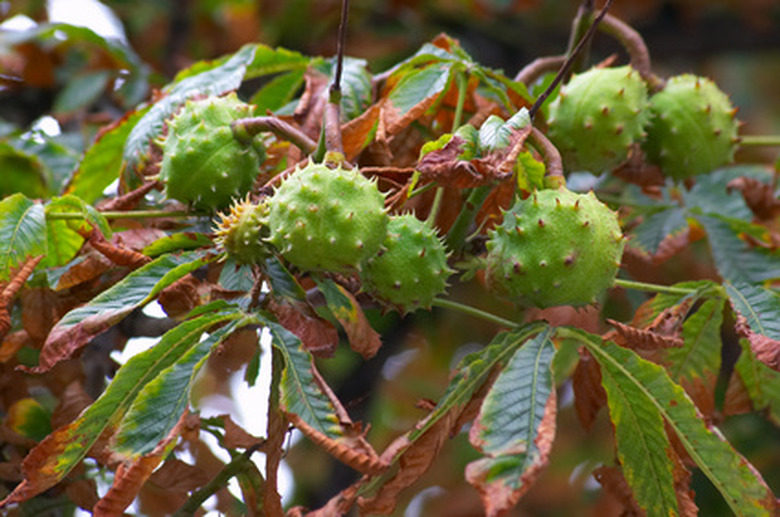Nut Bearing Trees In Ohio
Although the nuts responsible for the Buckeye State's nickname are toxic, many of Ohio's tree species produce edible nuts. Some of them do double duty as shade trees in Ohio's hot summers or provide harvests of strong, beautifully grained wood. Planting one of these trees in your Ohio garden will guarantee a grateful stream of visiting squirrels during nut season.
Chinese Chestnut
After blight nearly exterminated America's native chestnut tree (Castanea dentata) population in the early 20th century, Chinese chestnut (Castanea mollissima) arrived from China and Japan as a replacement. This cold hardy, blight-resistant tree's horizontal branches allow easy harvesting.
Normally reaching 40 to 50 feet, Chinese chestnut Chinese chestnut features lance-shaped leaves with deep green surfaces and lighter undersides. Leaves turn varying shades of yellow in fall. Its creamy white spires flowers–with a noticeably unpleasant smell, according to the Ohio Department of Natural Resources–appear in early summer, followed by spiny green burs containing two or three edible nuts.
- Although the nuts responsible for the Buckeye State's nickname are toxic, many of Ohio's tree species produce edible nuts.
- After blight nearly exterminated America's native chestnut tree (Castanea dentata) population in the early 20th century, Chinese chestnut (Castanea mollissima) arrived from China and Japan as a replacement.
Chinese chestnut likes a sunny location with moist, well-drained loam. Older trees can tolerate drought. Planting two trees increases the chances of cross-pollination and a larger chestnut crop.
Shellbark Hickory
A tree capable of growing 180 feet high with a 40-foot spread, shellbark hickory (Carya laciniosa) grows across Ohio, often in damp bottomlands. It produces the largest of all hickory nuts. Shellbark hickory has spikes of small pale green flowers in the spring. Female trees produce thick-shelled egg-shaped nuts that break open after ripening in the fall. They are a food source for several wildlife species.
- Chinese chestnut likes a sunny location with moist, well-drained loam.
- Shellbark hickory has spikes of small pale green flowers in the spring.
Disease-and-pest-resistant shellbark hickory needs a location with plenty of room and sun. It prefers rich, moist soil and benefits from occasional flooding, but becomes drought-tolerant as it matures. Place trees where fallen twigs, leaves and nuts aren't a nuisance.
Black Walnut
Another tree common in Ohio's wet bottomlands, black walnut (Juglans nigra) grows quickly, normally reaching 50 to 75 feet tall with up to a 70-foot spread. Trees planted in dry areas grow much more slowly. Their upright round form makes these trees attractive even in winter.
In April or May, they produce inconspicuous greenish-yellow flower spikes followed by green nuts that ripen to yellowish-brown. Ripe nuts release a dark stain when handled. Black walnut wood is in tremendous demand among furniture, veneer and gunstock manufacturers.
- Disease-and-pest-resistant shellbark hickory needs a location with plenty of room and sun.
- Another tree common in Ohio's wet bottomlands, black walnut (Juglans nigra) grows quickly, normally reaching 50 to 75 feet tall with up to a 70-foot spread.
Plant nursery trees in sun or part shade and moist, rich acidic loam. Black walnut trees release substance called juglone that prevents some other plants from near them. During prolonged drought, the nearly disease-and-pest-free trees will drop their leaves.
